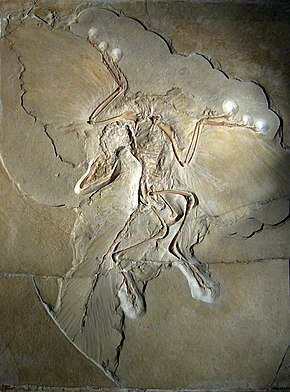
The scientific question of within which larger group of animals birds evolved has traditionally been called the "origin of birds". The present scientific consensus is that birds are a group of maniraptoran theropod dinosaurs that originated during the Mesozoic era.
A close relationship between birds and dinosaurs was first proposed in the nineteenth century after the discovery of the primitive bird Archaeopteryx in Germany. Birds and extinct non-avian dinosaurs share many unique skeletal traits.[1] Moreover, fossils of more than thirty species of non-avian dinosaur with preserved feathers have been collected. There are even very small dinosaurs, such as Microraptor and Anchiornis, which have long, vaned arm and leg feathers forming wings. The Jurassic basal avialan Pedopenna also shows these long foot feathers. Paleontologist Lawrence Witmer concluded in 2009 that this evidence is sufficient to demonstrate that avian evolution went through a four-winged stage.[2] Fossil evidence also demonstrates that birds and dinosaurs shared features such as hollow, pneumatized bones, gastroliths in the digestive system, nest-building, and brooding behaviors.
Although the origin of birds has historically been a contentious topic within evolutionary biology, only a few scientists still dispute the dinosaurian origin of birds, suggesting descent from other types of archosaurian reptiles. Within the consensus that supports dinosaurian ancestry, the exact sequence of evolutionary events that gave rise to the early birds within maniraptoran theropods is disputed. The origin of bird flight is a separate but related question for which there are also several proposed answers.
- ^ Chiappe, Luis M. (2009). "Downsized Dinosaurs: The Evolutionary Transition to Modern Birds". Evolution: Education and Outreach. 2 (2): 248–256. doi:10.1007/s12052-009-0133-4.
- ^ Cite error: The named reference
Witmer2009was invoked but never defined (see the help page).